Jewish Historical Fiction for Older Readers: The Holocaust (Page 1) |
If you wish to purchase any of these books, click on either the title or the book cover to be directed to Amazon.com. As a warning, I have put up pictures of the book covers to give you somewhat an idea of the style of each book (I know, I know. "Don't judge a book by its cover") so the pages may load slowly, depending on the speed of your internet connection.
If this page came up without frames, Click here to see the complete website
For biographies of individuals associated with the Holocaust (Anne Frank,
Simon Wiesenthal, etc.), go to the
Biographies
For Nonfiction Holocaust books, go to the
Holocaust History Page
For Holocaust books for younger readers, go to the Children's History Page
Other Pages of Interest:
Holocaust Historical Fiction Books For Middle School and Young Adult Readers ...
(Page 1)
(Page 2)
(Page 3)
(Page 4)
(Page 5)
(Page 6)
Holocaust History Books For Middle School and Young Adult Readers (Nonfiction)...
(Page 1)
(Page 2)
(Page 3)
(Page 4)
(Page 5)
(Page 6)
Middle School and YA Books ...
Bar Mitzvah Books |
Jewish Fiction |
Historical Fiction |
Torah Study |
Prayer and Jewish Life Books |
Jewish Holidays |
Jewish Biographies |
Jewish History Books |
Holocaust Books for Teens |
Israel Books
Jewish Historical Fiction for Middle School and YA Readers...
Biblical Era |
Middle Ages, Renaissance, and the Spanish Inquisition |
Immigration & The American Experience |
European History |
Holocaust
(Page 1)
(Page 2)
(Page 3)
(Page 4)
(Page 5)
(Page 6) |
Israel
Jewish History Books for Middle School and Young Adult Readers ...
General Jewish History & Nonfiction |
Biblical Era |
European History (Excluding the Holocaust) |
Immigration & The American Experience |
Holocaust |
Israel
Easy Reader and Picture Books ...
Jewish Children's Books (General) |
Jewish Board Books |
Biblical Stories for Children |
Jewish Holiday Books |
Jewish Family Cookbooks |
Folktales and Talmudic Stories for Children |
Jewish Life Books (Mitzvot, Keeping Kosher, etc.) |
Jewish Life Cycle Books |
Family Haggadahs |
Children's Prayerbooks |
Introductory Hebrew Books |
Jewish History and Historical Fiction Picture Books |
Israel Books
And More ...
Jewish Books for Children |
Bar Mitzvah Books |
Jewish Parenting Books |
Hanukkah Books |
Jewish Music for Children |
Jewish Videos |
Jewish Toys and Gifts |
Jewish Gift Baskets and Gourmet Food |
Jewish Jewelry |
Amazon.com Coupons, Promotions, and Sales
For biographies of individuals associated with the Holocaust (Anne Frank,
Simon Wiesenthal, etc.), go to the
Biographies
For Nonfiction Holocaust books, go to the
Holocaust History Page
For Holocaust books for younger readers, go to the Children's History Page
Other Pages of Interest:
Holocaust Historical Fiction Books For Middle School and Young Adult Readers ...
(Page 1)
(Page 2)
(Page 3)
(Page 4)
(Page 5)
(Page 6)
Holocaust History Books For Middle School and Young Adult Readers (Nonfiction)...
(Page 1)
(Page 2)
(Page 3)
(Page 4)
(Page 5)
(Page 6)
Middle School and YA Books ...
Bar Mitzvah Books |
Jewish Fiction |
Historical Fiction |
Torah Study |
Prayer and Jewish Life Books |
Jewish Holidays |
Jewish Biographies |
Jewish History Books |
Holocaust Books for Teens |
Israel Books
Jewish Historical Fiction for Middle School and YA Readers...
Biblical Era |
Middle Ages, Renaissance, and the Spanish Inquisition |
Immigration & The American Experience |
European History |
Holocaust
(Page 1)
(Page 2)
(Page 3)
(Page 4)
(Page 5)
(Page 6) |
Israel
Jewish History Books for Middle School and Young Adult Readers ...
General Jewish History & Nonfiction |
Biblical Era |
European History (Excluding the Holocaust) |
Immigration & The American Experience |
Holocaust |
Israel
Easy Reader and Picture Books ...
Jewish Children's Books (General) |
Jewish Board Books |
Biblical Stories for Children |
Jewish Holiday Books |
Jewish Family Cookbooks |
Folktales and Talmudic Stories for Children |
Jewish Life Books (Mitzvot, Keeping Kosher, etc.) |
Jewish Life Cycle Books |
Family Haggadahs |
Children's Prayerbooks |
Introductory Hebrew Books |
Jewish History and Historical Fiction Picture Books |
Israel Books
And More ...
Jewish Books for Children |
Bar Mitzvah Books |
Jewish Parenting Books |
Hanukkah Books |
Jewish Music for Children |
Jewish Videos |
Jewish Toys and Gifts |
Jewish Gift Baskets and Gourmet Food |
Jewish Jewelry |
Amazon.com Coupons, Promotions, and Sales
Other Pages of Interest:
Holocaust Historical Fiction Books For Middle School and Young Adult Readers ...
(Page 1)
(Page 2)
(Page 3)
(Page 4)
(Page 5)
(Page 6)
Holocaust History Books For Middle School and Young Adult Readers (Nonfiction)...
(Page 1)
(Page 2)
(Page 3)
(Page 4)
(Page 5)
(Page 6)
Middle School and YA Books ...
Bar Mitzvah Books |
Jewish Fiction |
Historical Fiction |
Torah Study |
Prayer and Jewish Life Books |
Jewish Holidays |
Jewish Biographies |
Jewish History Books |
Holocaust Books for Teens |
Israel Books
Jewish Historical Fiction for Middle School and YA Readers...
Biblical Era |
Middle Ages, Renaissance, and the Spanish Inquisition |
Immigration & The American Experience |
European History |
Holocaust
(Page 1)
(Page 2)
(Page 3)
(Page 4)
(Page 5)
(Page 6) |
Israel
Jewish History Books for Middle School and Young Adult Readers ...
General Jewish History & Nonfiction |
Biblical Era |
European History (Excluding the Holocaust) |
Immigration & The American Experience |
Holocaust |
Israel
Easy Reader and Picture Books ...
Jewish Children's Books (General) |
Jewish Board Books |
Biblical Stories for Children |
Jewish Holiday Books |
Jewish Family Cookbooks |
Folktales and Talmudic Stories for Children |
Jewish Life Books (Mitzvot, Keeping Kosher, etc.) |
Jewish Life Cycle Books |
Family Haggadahs |
Children's Prayerbooks |
Introductory Hebrew Books |
Jewish History and Historical Fiction Picture Books |
Israel Books
And More ...
Jewish Books for Children |
Bar Mitzvah Books |
Jewish Parenting Books |
Hanukkah Books |
Jewish Music for Children |
Jewish Videos |
Jewish Toys and Gifts |
Jewish Gift Baskets and Gourmet Food |
Jewish Jewelry |
Amazon.com Coupons, Promotions, and Sales
Holocaust History Books For Middle School and Young Adult Readers (Nonfiction)... (Page 1) (Page 2) (Page 3) (Page 4) (Page 5) (Page 6)
Middle School and YA Books ... Bar Mitzvah Books | Jewish Fiction | Historical Fiction | Torah Study | Prayer and Jewish Life Books | Jewish Holidays | Jewish Biographies | Jewish History Books | Holocaust Books for Teens | Israel Books
Jewish Historical Fiction for Middle School and YA Readers... Biblical Era | Middle Ages, Renaissance, and the Spanish Inquisition | Immigration & The American Experience | European History | Holocaust (Page 1) (Page 2) (Page 3) (Page 4) (Page 5) (Page 6) | Israel
Jewish History Books for Middle School and Young Adult Readers ... General Jewish History & Nonfiction | Biblical Era | European History (Excluding the Holocaust) | Immigration & The American Experience | Holocaust | Israel
Easy Reader and Picture Books ... Jewish Children's Books (General) | Jewish Board Books | Biblical Stories for Children | Jewish Holiday Books | Jewish Family Cookbooks | Folktales and Talmudic Stories for Children | Jewish Life Books (Mitzvot, Keeping Kosher, etc.) | Jewish Life Cycle Books | Family Haggadahs | Children's Prayerbooks | Introductory Hebrew Books | Jewish History and Historical Fiction Picture Books | Israel Books
And More ... Jewish Books for Children | Bar Mitzvah Books | Jewish Parenting Books | Hanukkah Books | Jewish Music for Children | Jewish Videos | Jewish Toys and Gifts | Jewish Gift Baskets and Gourmet Food | Jewish Jewelry | Amazon.com Coupons, Promotions, and Sales
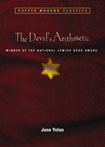 The Devil's Arithmetic By Jane Yolen  DVD Edition and VHS Edition also available |
Awards:
In this novel, Yolen attempts to answer those who question why the Holocaust
should be remembered.
Hannah, 12, is tired of remembering, and is embarrassed by her grandfather, who rants and raves at the mention of the Nazis. Her mother's explanations of how her grandparents and great-aunt lost all family and friends during that time have little effect. Then, during a Passover Seder, Hannah is chosen to open the door to welcome the prophet Elijah. As she does so, she is transported to a village in Poland in the 1940s, where everyone thinks that she is Chaya, who has just recovered from a serious illness. She is captured by the Nazis and taken to a death camp, where she is befriended by a young girl named Rivka, who teaches her how to fight the dehumanizing processes of the camp and hold onto her identity. When at last their luck runs out and Rivka is chosen, Hannah/Chaya, in an almost impulsive act of self-sacrifice, goes in her stead. As the door to the gas chamber closes behind her, she is returned to the door of her grandparents' apartment, waiting for Elijah. Through Hannah, with her memories of the present and the past, Yolen does a fine job of illustrating the importance of remembering. She adds much to children's understanding of the effects of the Holocaust, which will reverberate throughout history, today and tomorrow. The Holocaust was so monstrous a crime that the mind resists belief and the story must be made new for each individual. Yolen's book is about remembering. During a Passover Seder, 12-year-old Hannah finds herself transported from America in 1988 to Poland in 1942, where she assumes the life of young Chaya. Within days the Nazis take Chaya and her neighbors off to a concentration camp, mere components in the death factory. As days pass, Hannah's own memory of her past, and the prisoners' future, fades until she is Chaya completely. Chaya/Hannah's final sacrifice, and the return of memory, is her victory over the horror. The book's simplicity is its strength; no comment is needed because the facts speak for themselves. This brave and powerful book has much it can teach a young audience. Originally published in 1988, this award-winning novel about the Holocaust continues to have significance and appeal. Twelve-year-old Hannah is weary of observing Jewish holidays because she's "tired of remembering." During the Passover Seder, she finds herself mysteriously transported back to Nazi-occupied Poland in 1942. Her memories of 1990's America gradually fade, replaced by the horrors of her life in a concentration camp. Yolen depicts the harsh realities honestly, but compassionately, in this unforgettable story about survival, friendship, and remembering. Today's readers, increasingly dealing with issues of violence and prejudice, will especially value the learned skills Hannah utilizes to live with day to day hardship. This story does more than just remember the victims; it honors the survivors, and reminds that even in the midst of unspeakable sorrow, "the swallows still sing around the smokestacks." VHS Edition also available |
 Number the Stars By Lois Lowry |
Awards:
The evacuation of Jews from Nazi-held Denmark is one of the great untold stories of World War II. On September 29, 1943, word got out in Denmark that Jews were to be detained and then sent to the death camps. Within hours the Danish resistance, population and police arranged a small flotilla to herd 7,000 Jews to Sweden. Lois Lowry fictionalizes a true-story account to bring this courageous tale to life. She brings the experience to life through the eyes of 10-year-old Annemarie Johannesen, whose family harbors her best friend, Ellen Rosen, on the eve of the round-up and helps smuggles Ellen's family out of the country. Ten-year-old Annemarie Johansen and her best friend Ellen Rosen often think about life before the war. But it's now 1943 and their life in Copenhagen is filled with school, food shortages, and the Nazi soldiers marching in their town. The Nazi won't stop. The Jews of Denmark are being "relocated," so Ellen moves in with the Johansens and pretends to be part of the family. Then Annemarie is asked to go on a dangerous mission. Somehow she must find the strength and courage to save her best friend's life. There's no turning back now. |
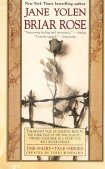 Briar Rose By Jane Yolen |
... Around the castle there grew a hedge of thorns, which every year grew higher, and at last there was nothing more to be seen, not even the flag upon the roof. But the story of the beautiful sleeping princess, Briar Rose, went about the country so that from time to time the King's sons came and tried to get through the thorny hedge ...
So goes the German fairy tale of Briar Rose, the Sleeping Beauty ... an old, old tale, yet so potent that few among us do not know it today. Now one of America's most celebrated writers tells it afresh, set this time in forests patrolled by the German army during World War II - a tale with no guarantee of an ending that reads they lived happily ever after. A young American journalist is drawn to Europe and to the past as she investigates the mystery of her grandmother's life. From her grandmother she inherited a silver ring, a photograph, and the traditional tale of Briar Rose: clues that will ultimately lead her to a distant land and an astonishing revelation of death and rebirth. The story of the Holocaust, like the story of Sleeping Beauty, is indeed familiar - yet such is a master storyteller's skill that along the way we learn the tale anew. This is a tale of life and death, of love and hate, despair and faith. A tale of castles and thorns and sharp barbed wire. This is Briar Rose. Part of the Fairy Tale series created by Terri Windling, Yolen's recasting of the Sleeping Beauty tale is not fantasy; rather, it is a story evocatively grounded in the horror of the Holocaust. Ever since Rebecca was a toddler, she and her two older sisters had heard a unique version of Sleeping Beauty over and over again from their beloved grandmother, Gemma, who insists that she is Briar Rose. Alternating chapters advance the fairy tale and Rebecca's experiences in trying to fulfill her promise made on Gemma's death bed to find the castle in the sleeping woods, which Gemma leaves to Rebecca. Rebecca's investigation takes her to her grandmother's native Poland, from which emerges a tale of Nazi brutality, gas chambers, partisan activity, courage, guilt, and love. Both heartbreaking and heartwarming, Yolen's novel is a compelling reminder of the Holocaust as well as a contemporary tale of secrets and romance. The latest in the Fairy Tales series begins with a provocative premise: retelling the story of Sleeping Beauty as a Holocaust memoir. Rebecca Berlin (Becca), the sweet young heroine, fondly recalls the odd version of Sleeping Beauty that her grandmother (Gemma) often told her and her sisters. Although Gemma always identified strongly with Briar Rose, the sleeping princess, no one had thought it anything but a bedtime story -- but when a mysterious box of clippings and photos turns up after Gemma's death, hinting that the accepted version of Gemma's origins is untrue, Becca begins tracing the real story, which bears striking resemblances to Gemma's fairy tale. The trail finally leads Becca to the site of an extermination camp in Poland. |
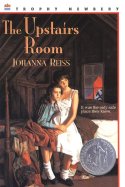 The Upstairs Room By Johanna Reiss |
Awards:
When the German army occupied Holland, Annie de Leeuw was eight years old. Because she was Jewish, the occupation put her in grave danger - she knew that to stay alive she would have to hide. Fortunately, a Gentile family, the Oostervelds, offered to help. For two years they hid Annie and her sister, Sini, in the cramped upstairs room of their farmhouse. Most people thought the war wouldn't last long. But for Annie and Sini - separated from their family and confined to one tiny room - the war seemed to go on forever. In the part of the marketplace where flowers had been sold twice a week-tulips in the spring, roses in the summer-stood German tanks and German soldiers. Annie de Leeuw was eight years old in 1940 when the Germans attacked Holland and marched into the town of Winterswijk where she lived. Annie was ten when, because she was Jewish and in great danger of being cap-tured by the invaders, she and her sister Sini had to leave their father, mother, and older sister Rachel to go into hiding in the upstairs room of a remote farmhouse. Johanna de Leeuw Reiss has written a remarkably fresh and moving account of her own experiences as a young girl during World War II. Like many adults she was innocent of the German plans for Jews, and she might have gone to a labor camp as scores of families did. It won't be for long and the Germans have told us we'll be treated well, those families said. What can happen? They did not know, and they could not imagine.... But millions of Jews found out. Mrs. Reiss's picture of the Oosterveld family with whom she lived, and of Annie and Sini, reflects a deep spirit of optimism, a faith in the ingenuity,backbone, and even humor with which ordinary human beings meet extraordinary challenges. In the steady, matter-of-fact, day-by-day courage they all showed lies a profound strength that transcends the horrors of the long and frightening war. Here is a memorable book, one that will be read and reread for years to come. |
 The Journey Back By Johanna Reiss |
Sequel to
The
Upstairs Room
Holland, 1945 - World War II has finally ended. For thirteen-year-old Annie de Leeuw and her sister Sini, almost three years of hiding from the Germans in the upstairs room of a remote farmhouse have also ended. Saying good-bye to the courageous family who hid them is very difficult. And Annie finds that being home again isn't easy either. Her mother is dead; her father, distant and distracted. Sini is out dancing with the soldiers every night, trying to make up for lost time, and Annie's oldest sister, Rachel, has become a Christian. Soon Annie has another problem - getting used to a new stepmother she cannot seem to please. Annie learns that though the fighting is over, some of the wounds of the war still remain. Her old home is gone. Now she must build a new life for herself. |
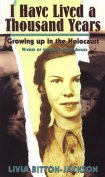 I Have Lived a Thousand Years : Growing Up in the Holocaust By Livia Bitton-Jackson |
In a graphic present-tense narrative, this Holocaust memoir describes what happens to a
Jewish girl who is 13 when the Nazis invade Hungary in 1944. She tells of a year of roundups,
transports, selections, camps, torture, forced labor, and shootings, then of liberation and the
return of a few. For those who have read Leitner's stark
The
Big Lie, this is a much
more detailed account, with the same authority of a personal witness. Horrifying as her
experience is, she doesn't dwell on the atrocities. There is hope here. Unlike many adult
survivor stories, this does not show the victims losing their humanity. The teenager and her
mother help each other survive; they save each other from the gas chambers. Even in the
slaughter of the cattle trucks strafed by machine-gun fire, "words of comfort emerge from
every corner." The occasional overwriting about "drowning in a morass of pain and
helplessness" is unfortunate. The facts need no rhetoric. On every page they express her
intimate experience. After the war, the teenager finds her brother, hears how her father
died. She wonders whether she dare enjoy the luxury of being a girl, of "having hair." A
final brief chronology of the Holocaust adds to the value of this title for curriculum use
with older readers.
Born in a small farming town in Hungary, Bitton-Jackson was 13 when Nazis forced her and her family into a Jewish ghetto and then sent them to Auschwitz. After a yearful of innumerable harrowing experiences, she was liberated. While the facts alone command attention, Bitton-Jackson's supple and measured writing would compel the reader even if applied to a less momentous subject. She brings an artist's recall to childhood experiences, conveying them so as to stir fresh empathy in the target audience, even those well-versed in Holocaust literature. She relates, for example, how the yellow star made her feel marked and humiliated, reluctant to attend her school's graduation; how existence in the ghetto, paradoxically, made her happy to be Jewish for the first time in her life; how an aunt terrified the family by destroying their most valuable belongings before deportation, so that the Germans could not profit by them. Her descriptions of Auschwitz and labor camps are brutal, frank and terrifying, all the more so because she keeps her observations personal and immediate, avoiding the sweeping rhetoric that has, understandably, become a staple of much Holocaust testimony. Of particular interest is her relationship with her mother, who survived with her (in part because of the author's determination and bravery after an accident left her mother temporarily paralyzed). An exceptional story, exceptionally well told. |
 My Bridges of Hope: Searching for Life and Love After Auschwitz By Livia Bitton-Jackson |
After liberation from Auschwitz, fourteen-year-old Elli, her brother, and their mother attempt to rebuild their lives in Czechoslovakia. But it doesn't take long for Elli to realize that even though the war is over, anti-Semitism is not, so she and her family decide to escape to America along with thousands of other Jews. Little do they know what agonies and adventures await them still. Elli's memoir of her experiences after Auschwitz will captivate readers as they follow her through heartache, frustration, adventure, excitement, love, and ultimately, triumph.
Bitton-Jackson recalls her arduous life immediately after World War II. Building on her I Have Lived a Thousand Years: Coming of Age in the Holocaust, she now tells how life begins again in 1945. Fourteen-year-old Livia, her older brother, and mother return to their village, now part of Czechoslovakia. They vow never to be separated again and plan to go to America, which Livia's brother is able to do within a year. While waiting for the virtually unobtainable permits to emigrate, the two women find work, despite lingering prejudice, and Livia attends Judaic classes. She participates in clandestine operations smuggling Jews to Israel and, compromising that very covert operation, smuggles her mother and herself onto an underground transport. The dangerous plan works, and Livia and her mother arrive in New York in 1951. Although the narrative switches quirkily between passionate entries and detached observations, the schism emphasizes the multiple and constant separations in Livia's life: "every parting is a minor death." A brief epilogue of the family's years to the present; a family chronicle of events; highlights of post-Holocaust events, and a glossary of terms add further context. Bitton-Jackson continues the memoir begun so searchingly in I Have Lived a Thousand Years. Now 14 and a survivor of Auschwitz, she returns with her mother and older brother to their once-Hungarian town in what has become Czechoslovakia. There they learn of her father's death; they find their house plundered, friendly-seeming neighbors reluctant to return their possessions and the local school, once a haven to Elli (as she is called here) completely re-staffed by the Communists. Readers will be awed at the bewildering maze of decisions facing Elli and her family. Should she apply for a visa to the U.S. or travel illegally to Palestine, as she, a member of an underground organization, is helping other Jews to do? When Elli and her brother get American visas, the family decides that her brother will go alone and try to expedite a visa for their mother. But years pass before they are reunited, and as the Americans close their embassy in Czechoslovakia, Elli dreams up and executes a breathtakingly daring escape for herself and her mother. It seems never to have occurred to Elli not to be brave; only once or twice does she express her agony at what she has witnessed in Auschwitz, and she resolutely works to make life better for those around her as well as her family. Bitton-Jackson's prose is not as fresh as in her previous book, and in some ways she is less personal, observing more and revealing herself less directly. But her story is utterly involving, and adds an important chapter to the ongoing attempt to understand the Holocaust and its consequences. Bitton-Jackson has written a worthy sequel to her Holocaust memoir I Have Lived a Thousand Years. Beginning the story in 1945 after her liberation from the concentration camps of Nazi Germany, Bitton-Jackson, then known as Elli Friedmann, relates the story of her family's years of struggle and attempts to emigrate to America. Elli and her mother and brother were among only thirty-six out of their town's more than five hundred Jewish citizens to return after the war. At age fourteen, Elli faced experiences and responsibilities beyond her years before finally reaching America in 1951. Her persistence in attaining her goals is exhibited through her efforts to return some stability to her family's life while seeking freedom from the memories of WWII and the post-war Communist takeover of Czechoslovakia. She pursues her education, becomes a teacher, works as a guide for the underground network helping Jews escape from Eastern Europe to Palestine, and also grows as a young woman awakening to feelings of first love. She eventually engineers her mother's and her own escape from behind the Iron Curtain, using her language skills to ease their journey through Displaced Persons Camps and achieve a reunion with her brother in New York. Bitton-Jackson's descriptive writing details the horrors of post-World War II Europe, while also effectively portraying an inner conflict over her yearning to go to Israel and her wish to keep her family together in hopes of a better future in America. Her sensitive nature extends this sequel beyond her Holocaust memoir to a coming-of-age story, albeit one of extraordinary events in extraordinary times, that should appeal to many teen readers. At fourteen, Livia, called Elli, and her mother and brother returned to their home in country that she no longer knows. She chose to go back to school, but there, even the language was no longer hers. Their house had been stripped even of its windows, and most of their neighbors denied keeping the furniture or clothing that had been entrusted to them for "safekeeping." The little family slowly became accustomed to life under a Communist government as DPs, Displaced People. But Elli discovered within herself a tremendous thirst for knowledge and a gift for languages. While witing to emigrate, she helps Jewish orphans and manages to escape from behind the Iron Curtain. Her mother had assumed that when the family finally reached America they would open a dress shop, but Elli had other plans. This is a wonderful story for anyone, not just for young people. The highly recommended sequel to I Have Lived a Thousand Years. |
 The Devil in Vienna By Doris Orgel |
Awards:
Inge Dornenwalk and Lieselotte Vessely are best friends, the kind of friends who almost always know what the other is thinking. But now they are thirteen and it is 1937 in Vienna. Inge is Jewish, and Lieselotte, at the insistence of her Nazi father, is in the Hitler Youth. Their friendship has become unwise, even dangerous, to sustain. Yet in a world of increasing terror and despair, as the situation of Jews in Austria becomes more and more desperate, Inge and Lieselotte secretly struggle against "the Devil in Vienna" to keep their friendship alive. |
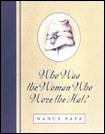 Who Was the Woman Who Wore the Hat? By Nancy Patz |
Awards:
Who was the woman who wore the hat I saw in the Jewish Museum? When did she buy it, and where did she wear it? I wonder if she wore it the day she left home the last time, that cold, cold day when the Jews were arrested in the Square. It could have been my mother's hat. It could have been my hat . . . or yours.
This book, a meditation on a woman's hat on display in the Jewish Historical Museum in Amsterdam, combines a pensive prose poem with arresting collage artwork. The illustrations, consisting of pencil drawings, subdued watercolors, and old photographs, sometimes suggest a distant memory and at other times bring the reality of the Holocaust into sharp focus. Subtle yet powerful, historical and personal, this book will have a lasting impact on everyone who experiences it. In this reflective poem drawn from a visit to the Jewish Historical Museum in Amsterdam, Patz recalls an exhibit she saw and asks, "Who was the woman/who wore the hat/I saw in the Jewish Museum?/What was she like?" In proselike poetry, the author poses questions about what the woman ate, whether she took cream in her coffee, and how she tilted her hat when she wore it. She reflects on whether the woman wore it the day she was arrested and taken to the Square in the Jewish Quarter. How did she know what she should pack, "Or how many sweaters/to put on each of her children-." Patz dramatically states on a spread with white letters against black paper that the hat might have belonged to her mother, herself, or you, the reader. Sepia-tone drawings and copies of old photographs are intentionally mixed together in a fragmentary manner, so as to "convey a sense of loss," as Patz states in the author's note. Loss is the perfect word for this simple, mournful poem reminding readers that the victims of the Holocaust went shopping, drank coffee, and wore hats like everybody else. When author Patz saw an unlabeled woman's hat in a glass case in the Jewish Historical Museum in Amsterdam, she wondered whose it could be. "Except for the winds of chance," she thought, "I might have been that woman." She drew the hat in her sketchbook and eventually created this quiet tribute to the woman--any Jewish woman-- who might have been forced to leave her home in Amsterdam for a cruel fate in the Nazi extermination camps. Patz combines an accessible prose poem ("What was she like? Did she lie awake in the morning / and watch / the way I did today, / as dawn brushed light through the sky?") with collages that blend historical photographs with her own sketches. A chronology of the Holocaust completes the book, which is as much about trying to personalize history as it is about the Jewish experience of the Holocaust: "Who was the woman? Whom did she love? And did she put cream in her coffee?" Teachers might use this subtle, meditative book as a supplement to Holocaust curriculum or as a tool to discuss the study of history itself. |
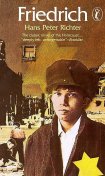 Friedrich By Hans Peter Richter |
His best friend thought Friedrich was lucky. His family had a good home
and enough money, and in Germany in the early 1930s, many were
unemployed. But when Hitler came to power, things began to change. Friedrich
was expelled from school, and then his mother died and his father was deported.
For Friedrich was Jewish.
|
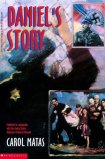 Daniel's Story By Carol Matas |
Can Daniel survive history's deadliest moment?
Daniel barely remembers leading a normal life before the Nazis came to power in 1933. He can still picture once being happy and safe, but memories of those days are fading as he and his family face the dangers threatening Jews in Hitler's Germany in the late 1930s. No longer able to practice their religion, vote, own property, or even work, Daniel's family is forced from their home in Frankfurt and sent on a long and dangerous journey, first to the Lodz ghetto in Poland, and then to Auschwitz - the Nazi death camp. Though many around him lose hope in the face of such terror, Daniel, supported by his courageous family, struggles for survival. He finds hope, life, and even love in the midst of despair. Although Daniel is a fictitious character, his story was inspired by the real experiences of many of the more than one million children who died in the Holocaust. Daniel's Story was published in conjunction with an exhibit called "Daniel's Story: Remember the Children" at the United States Holocaust Memorial Museum in Washington, D.C. After witnessing the rising tide of anti-Semitism in Nazi Germany, Daniel is suddenly transported, at age 14, from his comfortable life in Frankfurt to a Polish ghetto, then to Auschwitz and Buchenwald--losing most of his family along the way, seeing Nazi brutality of both the casual and the calculated kind, and recording atrocities with a smuggled camera ("What has happened to me?...Who am I? Where am I going?"). Matas, explicating an exhibit of photos and other materials at the new United States Holocaust Memorial Museum, creates a convincing composite youth and experience--fictional but carefully based on survivors' accounts. It's a savage story with no attempt to soften the culpability of the German people; Daniel's profound anger is easier to understand than is his father's compassion or his sister's plea to "chose love. Always choose love." Daniel survives to be reunited, after the war, with his wife-to-be, but his dying friend's last word echoes beyond the happy ending: "Remember..." An unusual undertaking, effectively carried out. Daniel, 14 in 1941, describes first his family's sense of belonging in Germany and their refusal to flee their country despite the initial instances of anti-Semitism they experience. By the time the family is ready to acknowledge the seriousness of their situation, no country is willing to accept them. They are first deported from Frankfurt to the Lodz ghetto in Poland; from Lodz they are sent to Auschwitz, and finally, Daniel and his father are marched to Buchenwald. They are the only two members of the family who survive, and are liberated by the Americans. Daniel tells his story through the "pictures" he has; at first real photographs, and then the images in his head. He is a courageous, sensitive, heroic individual who personalizes the events of the Holocaust. His voice rings true; he is portrayed as an extraordinary youth, but these were times that demanded an exceptional response to increase the likelihood of survival. |
 Jacob's Rescue : A Holocaust Story By Malka Drucker |
At her family's traditional Passover seder in Israel, eight-year-old
Marissa hears the story of her father Jacob and her Uncle David's
experiences as children in Warsaw during the Holocaust. Alex and
Mela hide the boys on their home. After the war, the authorities
insist that Jacob and David must leave the people they now regard
as their parents, and it is sixteen years before the boys locate them
again. This is a heartening novel, based on a true story, of great
courage in the midst of the madness of war.
Once Jacob Gutgeld lived with his family in a beautiful house in Warsaw, Poland. He went to school and played hide-and-seek in the woods with his friends. But everything changed the day the Nazi soldiers invaded in 1939. Suddenly it wasn't safe to be Jewish anymore. One afternoon, eight-year-old Jacob slipped through a hole in the ghetto wall to meet Alex Roslan, a kind Christian man who agreed to be his new "uncle." The Roslan family, at the risk of their own lives, kept Jacob's identity as a Jew hidden. Every day of hiding meant a new danger and a threat of discovery. Jacob worried about his real family and longed to go to school and play outside like the Roslan children. The fear, the hunger, and the hardships brought Jacob closer to the Roslan family -- until at last they were able to begin a new chapter in their lives. The year that she is eight, Marissa asks a fifth question at the family Passover Seder. She wants to know who the two guests are who have been staying with her family; they are participating in and enjoying the Seder, and they're "not even Jewish.'' The response is what her father calls a story from the heart, the story of how Alex and Mela Roslan saved him and his brother during the Holocaust. The remainder of the book is that story, set in Poland between 1941-1945. Characters are well developed and multidimensional, and the story is a poignant one. While it might be difficult for today's readers to understand the kind of heroism and goodness demonstrated by the Roslan family, who risked their lives every day to protect children who were not even related to them, they will become immersed in another time and place. Powerful emotions are described and presented in an understandable format. This is a fictionalized account of a true story and real people. |
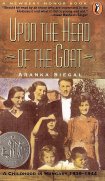 Upon the Head of the Goat : A Childhood in Hungary, 1939-1944 By Aranka Siegal |
Awards:
Nine-year-old Piri describes the bewilderment of being a Jewish child during the 1939-1944 German occupation of her hometown (then in Hungary and now in the Ukraine) and relates the ordeal of trying to survive in the ghetto. |
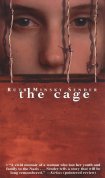 The Cage By Ruth Minsky Sender |
From the German invasion of Poland in 1939 to the liberation of her
concentration camp in 1945, the author chronicles an adolescence
shaped by the horrors of the Holocaust but strengthened by the force
of her own will. Often painful but impossible to put down, her story
is a testament to human faith and fortitude.
|
 To Life By Ruth Minsky Sender |
"We Are Free!"
When Russian soldiers liberate Grafenort, the Nazi labor camp where she is a prisoner, nineteen-year-old Riva discovers that liberation doesn't mean the end of her hardship and suffering. Cold and starving, threatened with rape by the same Russian soldiers who were her saviors, Riva makes her way to her old home in Poland, searching like so many others for family who may have survived. Strengthened by her mother's credo, as long as there is life, there is hope, and by the promise of a new love and a new life, Riva endures the long years of waiting for real freedom and a real home. Picking up where her acclaimed memoir The Cage leaves off, Ruth Minsky Sender has written another inspirational document of the power of hope and love over unspeakable cruelty. Holocaust survivors faced an unexpected challenge after liberation from the concentration camps. They found themselves both homeless and stateless. In this beautiful sequel to Sender's extraordinary memoir, The Cage, readers learn how nineteen-year-old Riva traveled back to Lodz, Poland only to find no traces of her younger brothers or mother. Like other survivors, Riva's home has been taken over by Poles and she must sleep in temporary shelters. These shelters also serve as message centers as survivors post letters to the loved ones they hope to find. Riva meets another young survivor named Moniek. They marry and travel to a displaced persons camp in Germany where they begin a five-year wait for visas to America. During this time, Riva is fortunately reunited with three older siblings who escaped to Russia before the war. She also gives birth to two healthy children. Without bitterness or sentimentality, Sender describes what it was like for Holocaust survivors to rebuild their lives in a world that refused to welcome them. The refrain from The Cage, "while there is life, there is hope" takes on an even deeper meaning in this poignant memoir. |
 Anne Frank and Me By Cherie Bennett and Jeff Gottesfeld |
The successful play is now a gripping novel.
Knocked unconscious after explosions ring out during a field trip to an Anne Frank exhibit, boy-crazy Nicole Burns wakes to find herself living a parallel life as a Jew in 1942 Paris. This Nicole is dating the boy of her present-day dreams, but living under the Nazis gradually becomes a nightmare. Her family survives the Nazi occupation with the help of friends, but when her father is exposed as a resistant, their fate takes a dire turn. The shifts in Nicole's lives-from a carefree, sophisticated Parisian girl to a wretch riding in a cattle car with Anne Frank; from a modern girl focused only on the drama of her high school life to a thoughtful observer of the potential of everyday injustices-will engage teens and change their views of history found in books and the history we're making today. Called "eloquent and poignant" by the New York Times and performed to wide acclaim across the country, the play has touched thousands. As a novel, it is sure to grow in popularity. As Nicole Burns' tenth-grade class is touring the Anne Frank in the World exhibit, shots ring out and she is injured, catapulting her into World War II France. In this time warp, she is Nicole Bernhardt, the daughter of a prominent Jewish doctor and his wife who bear a remarkable resemblance to her history teacher and high-school principal. Her world becomes one in which she must endure the early indignities of being Jewish, enforced hiding as the Germans tighten their hold on France, and the eventual horrors of a Nazi concentration camp. Similar but less tightly constructed than Jane Yolen's The Devil's Arithmetic, this novel is strongest as Nicole gradually forgets her twenty-first-century existence and becomes totally a Jewish teen of the 1940s. As a book, this adaptation of a well-reviewed off-Broadway play, is a didactic counterpart to The Diary of Anne Frank and Yolen's novel. Nicole Burns, like Anne Frank, is an affluent teenager who would rather flirt than study. She avoids her parents—a father who intellectualizes his feelings and a mother who cannot make it through dinner without closing a real estate deal—and she considers Little Bit, her sister, a pest. Nicole is too busy obsessing about her ideal boyfriend, Jack, on her Web site, Notes from Girl X, to read Anne Frank's Diary or watch a television production of Jane Yolen's The Devil's Arithmetic, both English assignments. Using the Internet to bone up on Anne Frank, Nicole stumbles upon some "scholarly looking articles" that minimize the severity of the Holocaust, a viewpoint that is reinforced by her father. When Paulette Litzger-Gold, a Holocaust survivor, speaks to the English class, however, Nicole realizes a mysterious connection. While on a Holocaust field trip, a firecracker explosion attributed to the class outcast, Doom, knocks out Nicole and transports her to a different time. She becomes Nicole Bernhardt, a Jew in 1942 Paris. Her principal and her English teacher become her parents in this allegorical world, offering family tradition and guidance not found in her real family. She must help her family survive the camps and trust her friends to help. As Nicole Bernhardt is dying in the gas chamber, Nicole Burns is being revived. Based on Bennett and Gottesman's 1997 play of the same name, this novel modernizes Nicole's story with the addition of the Internet, and the characters of Mrs. Litzger-Gold and Doom help to emphasize the importance of witnessing, remembering, and seeking truth. Shallow and apathetic, Nicole Burns reaches across time in this complex coming-of-age, time-travelnovel that manages the many allusion-based plot threads well. As Nicole Bernhardt shares a cattle car with Anne Frank, she identifies with the girl and the story that Nicole Burns dismissed. Nicole Burns returns to her world with a better understanding of how honoring the truth about the past will help to safeguard the future. Young adults who have read Anne Frank's diary and Yolen's time-travel story might find wonderful comparisons and contrasts here and might be motivated to read more about the Holocaust. Nicole Burns is a typical suburban American 10th-grader, irritated by school and by her little sister. Her main concern is that she is in love with a boy who seems to be unaware of her. Then, on a school field trip to an exhibit about Anne Frank, Nicole falls and hits her head. When she regains consciousness, she finds that she is a Jewish teenager named Nicole Bernhardt living in Paris during the Nazi occupation. In The Wizard of Oz fashion, people from Nicole's American life appear in different guises in her Paris incarnation. At first she thinks she must be in a dream, but as time goes on she grows to accept her new identity, as all the while life becomes more and more difficult and dangerous for the Jews of Paris. Nicole experiences the horror of the roundup of foreign Jews at the Vélodrome d'Hiver, and learns that her father is a member of the Resistance, despite the danger involved. Her friends help the family survive as food becomes scarce, and finally they go into hiding, like Anne Frank. Betrayed by her boyfriend, Nicole and her little sister are taken away in a cattle car—and meet Anne Frank on the train. On arrival at Birkenau, the little sister is sent to the ovens, and in a heartbreaking scene, Nicole chooses to go with her—and then comes back into her old life as Nicole Burns at the Anne Frank exhibit, shaken and changed by her strange trip into the past. Based on the authors' off-Broadway play of the same title, this is a powerful and affecting story. Narrated by Nicole, it makes the deprivations and degradation of the Nazi occupation come alive. Even if Nicole's trip back in time stretches belief, her emotions are always credible, from her changingfeelings toward her family to her romance with her Paris boyfriend (the boy who ignored her in America), her boredom and terror while in hiding, and her bravery as she and her sister are being transported toward a concentration camp. This gripping story is an excellent companion to The Diary of Anne Frank and to studies of the Holocaust. |
 The Grey Striped Shirt : How Grandma and Grandpa Survived the Holocaust By Jacqueline Jules |
While visiting her grandparents, Frannie discovers an old striped
shirt, and eventually musters up the courage to ask why her
grandmother has saved this ugly garment. Slowly, over a period of
years, her grandparents share with her their experiences during the
Holocaust. What makes this title different from others is that Frannie
asks the question, "'Why didn't the Jews fight back? Why didn't
they do something to keep the Nazis from killing them?'" Some of
the acts of the resistance movements are explained, but Grandma
states the most meaningful act of all, "'We fought the Nazis by
staying alive.'" And it is up to Frannie to tell their story and keep it
alive. The dedication of the grandparents to celebrating life is evident
not only in their love for their grandchild, but also in their beautiful
garden. This is a moving book, just perfect for those too old for David
Adler's The
Number on My Grandfather's Arm, and not quite ready for Lois Lowry's
Number
the Stars. It is amply
illustrated with full-page black-and-white pictures that capture the
moods and emotions of the text.
|
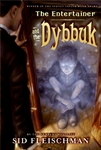 The Entertainer and the Dybbuk By Sid Fleischman |
Avrom Amos likes to crack jokes. He loves the spotlight. And if he wants something, he knows how to get it. He's just like any other boy, except for one thing: He's a ghost—a dybbuk. During World War Two he'd been murdered by the Nazis, right after he saved the life of a young ventriloquist named Freddie.
Freddie doesn't know it yet, but he's about to return the favor. Because the dybbuk wants revenge, and he knows exactly how to get it. Motivated, as he explains in his afterword, to create a personal remembrance of the 1.5 million Jewish children killed in the Holocaust, Fleischman pairs Freddie, a struggling, ex-GI ventriloquist, with Avron, the ghost of one such victim, in a short, provocative tale that leavens the tears with laughter. Freddie's career isn't exactly taking off as he wanders postwar Europe—until he opens a closet and discovers smart-mouthed Avron, who offers to put a better line of patter into Freddie's mouth in exchange for help finding a certain murderous SS officer. Countering Freddie's understandable reluctance with both gags and gut-wrenching war stories, Avron moves in, and Freddie begins to display stunning vocal tricks to ever-larger audiences. Avron then cajoles his host into keeping kosher, and even undergoing an ersatz (or is it?) bar mitzvah. Ultimately, the search takes the two to America, where in a satisfying (if credulity-straining) climax, they find their quarry standing trial for a new crime, and Avron exacts a triumphant revenge for the old ones. The narrative voice here sounds adult, but the talented Fleischman is still both entertaining and thoughtful. Avron's wisecracking will counterbalance matter-of-fact accounts of Nazi cruelty for young readers, but it's likely to be older ones who will best appreciate the novel's eloquent "inner voice" of conscience, which takes on a definite symbolic cast, and the way in which Freddie's public and private identities shift as the story progresses. |
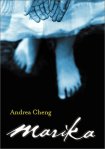 Marika By Andrea Cheng |
In this compelling first novel, a Hungarian girl comes to terms with being a Jew during World War II.
Marika covers roughly ten years in the life of a Hungarian girl named Marika, the only daughter of a wealthy stockbroker and his wife. Marika is six years old when WWII erupts, and for her the war is far away. At first it intrudes on her life only on occasion, such as when her uncle advises her to give her rag doll Maxi "less Jewish" name, or when her father urges her to attend Catholic mass with her classmates rather than to study "Israelite religion" with her friend Zsofi. But aside from news of war and of the danger faced by Jewish friends and relatives in other countries, life around Marika is quiet and ordinary. Her biggest concern is her parents' separation and the wall that has been built in their house to create a separate apartment for her father. As the war comes closer to Budapest, however, Marika finds that there is no escape from the fact that, by Hitler's definition, she and her family are Jews. In this promising debut novel, Cheng sensitively mines her mother's experiences as the daughter of assimilated Jews in 1930s and '40s Budapest. Marika, age six, worries much more about her parents' separation than about her uncle's advice to change the name of her doll from Maxi to something "less Jewish": "Everything I had heard about being Jewish or not Jewish was crazy anyway.... Really, we were no more Jewish than [the nanny] or the cook." Apa, her father, advises her to think of herself as Roman Catholic, and Marika, who narrates, is happy to agree. Apa is strong and charismatic, unlike Marika's odd mother, who is so ineffectual that even Marika calls her by her first name, Anya. Cheng stays true to her protagonist's perspective as Marika comes of age over 10 cataclysmic years. While Apa and his brother anxiously track Hitler's rise in faraway Germany (and take measures to protect themselves), Marika reports on more personal indications of unrest-among them, her changing status at school, where kids start whispering that she shouldn't be attending mass, and the bullying by local boys near the family's country house that makes her regard her stay there as dangerous rather than restorative. The author inhabits the character so smoothly that her story reads almost like memoir; readers will almost certainly be moved by her evocation of Marika's lost world. In 1934, Marika is six. Her world in Hungary is very ordinary; her biggest concerns are school and the wall dividing her home into two apartments: one for her father, the other for her mother, brother, and herself. Although her family is Jewish, they live like Christians, celebrating Christmas and going to mass. As she grows older, the war comes closer, and she begins to feel its effects. When she is 16, the Nazis take over the country, and she poses as the Catholic niece of a family friend. Deceptively simple, the story, told in first person, captures a child's life as she grows into the realization of the horrors around her. Marika is a well-realized and sympathetic character, believable in both her childlike concerns and her more adult fears as the war affects her directly. Her family is realistically flawed, especially her beloved father, who has an affair with a neighbor's wife, yet does everything he can to shelter Marika from harm. At times the brevity of the story makes it seem rather disjointed, but Cheng brings Marika and her world alive with her simple prose, investing readers in the protagonist's life. There is a lot of World War II and Holocaust literature available for young people, but libraries needing a fresh voice could consider adding this intriguing offering. Being Jewish means nothing to 12-year-old Marika Schnurmacher in Budapest, Hungary, in 1939. She and her brother have been baptized, and they go to Catholic mass. Who cares anyway? Even the war is distant. Marika's real problems are at home: her parents are separated, her father has a mistress; and her mother is an embarrassment with her fancy clothes and jewelry. But as the war comes closer and the Nazis take over in 1944, Hungarian anti-Semitism becomes violent, and Marika must fake her identity to survive. Cheng, who bases her novel on her mother's story, tells what happens in the first person, in short, dramatic chapters that capture the viewpoint of a young girl in an affluent, assimilated, unhappy home. The passage of time is not always clear, especially when the narrative suddenly jumps to 1944, and Marika sounds the same whether she's 12 or 16. But the clear, quiet prose ultimately tells a riveting story not only about the Nazi terror and Hungarian anti-Semitism but also about families and their secrets. |
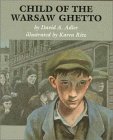 Child of the Warsaw Ghetto By David Adler |
Adler and Ritz use a picture-book biography to personalize what
happened to millions of Jews under the Nazis. This is the story of
Froim Baum, a Holocaust survivor now living in the U.S., who was
born to a poor Jewish family in Warsaw in 1926. With the boy's
personal biography, Adler weaves together the history of Hitler's
rise to power, the Nazi invasion of Poland, the raging anti-Semitism,
the herding of more than 400,000 Jews into the walled Warsaw
ghetto, and, finally, the death camps. Froim found shelter in the
orphanage of the beloved Janusz Korczak and moved between
there and home. The story is told with restraint, never exploitative,
never sweet. Overwhelmingly, what we see is that this child
survived by a mixture of cunning, courage, and sheer accident.
The realistic pictures are grim, increasingly brown and gray as the
genocide crowds out the light. Several illustrations evoke the
photos of the time: the beggars in the street; the skeletal people
piled on bunks. There's a lot of history compressed here -- some
of it may be too much for kids to understand on their own -- but
this one child's story is a compelling way to focus group discussion
on how the unimaginable happened and why.
A picture book for somewhat older readers relates the experiences of a Jewish boy growing up in Poland during World War II. Froim Baum smuggles food from outside the walls of the Warsaw ghetto and eventually survives a succession of concentration camps, although most of his family does not. The dark, solemn illustrations and understated text add a quiet dignity to the account. |
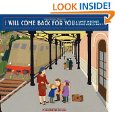 I Will Come Back for You: A Family in Hiding During World War II By Marisabina Russo |
What was it like to grow up Jewish in Italy during World War II? Sit with a little girl as her grandmother tells the story of her childhood in Rome, of being separated from her father, and of going into hiding in the mountains. Based on the experiences of the author's own family, this deeply moving book set during the Holocaust deals with a difficult subject in a way that is accessible and appropriate for young readers. I Will Come Back for You is an incredible story of bravery and kindness in the face of danger.
|